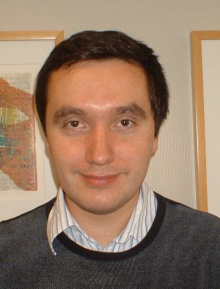Cavitand-bases Anoin receptors and self assembled (hemi)capsules in polar competitive media.
Promotion Date: 23 March 2006
| It is fairly complex to explain. I would like to compare the molecules I have been working with, with crocodiles. One part of my thesis was to develop these molecules in such a way that they can recognize what is in the water or in any other solution and the other part was to communicate with these 'crocodiles'. The molecules were made by self-assembly |
Promotion Date: 23 March 2006
What was your thesis about?
It is fairly complex to explain. I would like to compare the molecules I have been working with, with crocodiles. One part of my thesis was to develop these molecules in such a way that they can recognize what is in the water or in any other solution and the other part was to communicate with these 'crocodiles'. The molecules I worked with are shaped like a basin (cavitand) and are negatively charged (anion). An important part was also that these molecules I made had to be soluble in water. The molecules were made by self-assembly.
What is so special about your self-assembled 'crocodile' molecules?
There are several interesting things. They are soluble in water and are very good receptors for organic and an-organic anions. We have developed new methods for the communication with these molecules. With mass spectrometry we can establish how many anions these crocodile molecules have eaten.
What is the purpose of it all?
These molecules are made to recognize other substances, either in a solution or on surfaces. So they are receptors. But it is a fundamental study, no actual applications are in sight as yet. But we can control the substances in a solution with this kind of molecule, and get information about the solution as well. You could perhaps see the crocodile as a kind of chemical tool. Possible future applications could be cleaning up of polluted water for instance.
Where are you from?
Ukraine.
How did you get here?
I saw an announcement and I applied. The announcement was sent to our group, to Professor Vitaly Kalchenko of the Institute were I was working. He is a colleague of Professor David Reinhoudt.
Did you have a language problem when you arrived here?
(Answers the question in perfect Dutch): The Dutch language was a bit difficult and English also presented a bit of a problem, because up till then I had studied English from books only.
Did you like it here?
It was interesting, a new place. I enjoyed being part of a really famous group, David Reinhoudt is a very important scientist in the field. I also learned a lot about different cultures, since the group is very international.
What are your plans?
I have got a job now in Toulouse at the Laboratoire de Chimie de Coordination. I have already started work there.

